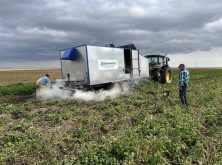Q: How can I improve weed control in my crops?
A: There is a constant demand to improve overall weed control in our crops. Pre-seed herbicides are the initial application providing the base for that growing season.
Growers battle change across the weed spectrum combined with the challenge of weed resistance management. Producers often ask, “What can I do differently to address these issues?” It would be great if we could hit the “easy button” and have a new chemical solution, but that is probably not sustainable.
Read Also

Claas brings 1000 Series SP forage harvesters to Canada
In mid-August, Claas unveiled its new line of Jaguar forage harvesters at an event in Visalia, California, deep in the heart of that state’s dairy region.
Every time we introduce a new chemical, pests adapt. The solution to superior weed control is a combination of doing the basics properly and utilizing all of the current options that researchers and manufacturers have provided. Finally, I’m optimistic that we will have some new herbicide options in the future, but also there will be significant new application improvements that will advance weed control.
First, the basics. Knowing the issue in every field is step one — that’s scouting and record keeping. Next is crop selection, proper nutrition, crop rotation, proper seeding rates, etc. Reducing the seed bank reduces weed competition and slows resistance.
Second, when selecting a pre-seed solution, consider all of the variables. Remember, this is the first spray of the season and there will be a sequential treatment in crop. It’s important to rotate chemistries, consider a contact versus a residual product, utilize multi-mode action products or herbicide layering to combat resistance. Also, be aware that some products require moisture to activate and know the limitations of that product.
New herbicide groups that address herbicide-resistant weeds are difficult to discover and slow to enter the market, but manufacturers are heavily investing in these. More often, we see new combinations of current products. This provides immediate solutions. We have seen the growth in chemical groups 13, 14 and 15 lately.
Finally, application technology will have a significant effect on improving weed control. The benefits of GPS, better spray tips and sectional control are invaluable. The next advancement, “green on brown” application for pre- seeding, provides another weapon in the battle of weed control.
The sprayer system detects green growth on soil. Thus, the application of chemicals is made directly to weeds and limits waste. The benefits are numerous. First, you use less chemical and save money. Second, the environmental load is lower and sustainability increases. As far as weed control is concerned, growers may be able to use more consistent (higher priced) chemistry than they normally would. The grower may also be able to use more applications because of less product or use and more combination products.
Weed control is tough but advancements made in products and application technology will help.















